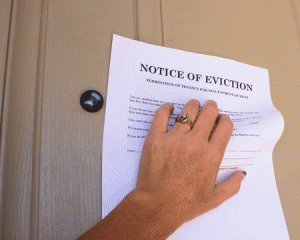The Process of Evicting a Tenant
 One of the most difficult and frustrating issues that landlords must contend with is eviction. When tenants do not pay their rent or are not living up to the terms of their lease agreement, the landlord has the right to evict them from the premises. The correct steps for eviction must be followed according to law. There are a number of steps to be taken before hiring a process server to deliver the final eviction notice.
One of the most difficult and frustrating issues that landlords must contend with is eviction. When tenants do not pay their rent or are not living up to the terms of their lease agreement, the landlord has the right to evict them from the premises. The correct steps for eviction must be followed according to law. There are a number of steps to be taken before hiring a process server to deliver the final eviction notice.
Step 1: The Written 3-Day Notice
The landlord, or other authorized person doing the eviction, begins the process by writing a 3-Day Notice which includes only business days that are not legal holidays or the day of service. The notice may be mailed, hand delivered, or posted on the tenant’s door.
Step 2: The 5- and 20- Day Summons
If there is no response from the tenant after the 3-day notice period, the landlord may file a case with the Clerk of Court to initiate the eviction process. For cases in which the landlord wishes to pursue back rent, both the 5- and 20- day summons must be obtained. If no back rent will be sought and the goal of the landlord is to have the residents vacate the premises, the 5-day summons needs to be obtained and posted on the tenant’s door or served by a process server. Each adult who is being evicted must be served with a summons.
Step 3: Writ of Possession
The Writ of Possession is a 24-hour process that takes place through the Clerk of Court’s office. From the Clerk of Court’s office, the Writ of Possession goes to the deputy. If the people have not left the property at the given time, they will be escorted from the premises. It is up to the landlord to remove the personal property and leave it at the curbside. If the people are invited inside to take possession of their property, the eviction process must be started all over again.
